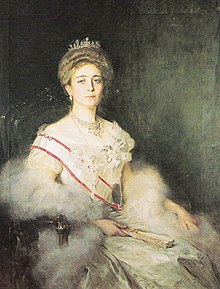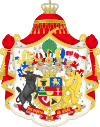Duchess Jutta of Mecklenburg-Strelitz
| Duchess Jutta | |||||
|---|---|---|---|---|---|
| Crown Princess of Montenegro | |||||
 | |||||
| Born | 24 January 1880 Neustrelitz, Mecklenburg-Strelitz, German Empire | ||||
| Died | 17 February 1946 (aged 66) Rome, Kingdom of Italy | ||||
| Burial | |||||
| Spouse | |||||
| |||||
| House | Mecklenburg-Strelitz | ||||
| Father | Adolphus Frederick V, Grand Duke of Mecklenburg-Strelitz | ||||
| Mother | Princess Elisabeth of Anhalt | ||||
| Religion | Serbian Orthodox prev. Lutheranism | ||||
Duchess Jutta of Mecklenburg-Strelitz (Augusta Charlotte Jutta Alexandra Georgina Adophine; 24 January 1880 – 17 February 1946) was a member of the House of Mecklenburg-Strelitz and the consort of Crown Prince Danilo of Montenegro. When a married woman, after being converted to the Orthodox faith, she was known as Militza.
Early life and marriage[edit]
Duchess Auguste Charlotte Jutta Alexandra Georgina Adolphine of Mecklenburg-Strelitz was born in Neustrelitz, the youngest daughter of Adolf Friedrich, the then Hereditary Grand Duke of Mecklenburg-Strelitz, and his wife Princess Elisabeth of Anhalt.[1] Along with her sister Marie, Jutta was raised by governesses and had little contact with her parents.[1] The atmosphere of Carolinenpalais was noted for its rigor and need for etiquette.[1] A scandal broke out when her 19-year-old sister became pregnant by a palace servant.[1]
Through the influence of the German Emperor, William II, her marriage to the heir apparent of Montenegro Prince Danilo was arranged.[2] Hours after her arrival at Antivari in Montenegro she converted to the Orthodox faith. She was accompanied by her future brother in law the Crown Prince of Italy, Victor Emmanuel as she made her way to Cetinje for her wedding.[3] She married Prince Danilo on 27 July 1899. After her marriage and conversion to Orthodoxy she took the name Militza.
World War I and later life[edit]
During the First World War, Montenegro fought against the Central Powers which included the country of her birth, the German Empire. These links did not stop her from being a target; the villa in Antivari where she was staying was bombed by Austrian aircraft.[4] After the war, the Royal Family established a government in exile after Montenegro was incorporated into the new Kingdom of Serbs, Croats and Slovenes. Her father-in-law King Nicholas I died on 1 March 1921 and her husband succeeded as titular King of Montenegro. He only held the position for a week before abdicating in favour of his nephew Michael.
Jutta spent the rest of her life in exile. She and her husband lived in France. Crown Prince Danilo died in Vienna, Austria in 1939. As the couple didn't have children, pretensions for the throne of Montenegro passed to Michael, Prince of Montenegro, eldest surviving son of Danilo's younger brother, Prince Mirko of Montenegro and his former wife, Countess Natalie Errembault de Dudzeele.
Death[edit]
Princess Jutta died on 17 February 1946 in Rome, Italy where she lived in exile, welcomed by her sister-in-law Elena of Montenegro and her husband, King Victor Emmanuel III. She was buried in the Protestant Cemetery, Rome. [5]
Ancestors[edit]
| Ancestors of Duchess Jutta of Mecklenburg-Strelitz |
|---|
References[edit]
- ^ a b c d Pope-Hennessy, pp. 340-341.
- ^ The Near East from Within. Adamant Media Corporation. 2002. p. 202. ISBN 1-4021-9724-1.
- ^ Willets, Gilson (2004). Rulers of the World at Home. Kessinger Publishing. p. 306. ISBN 1-4179-1739-3.
- ^ "Danilo's Villa Wrecked". The New York Times. 1914-11-16. p. 3.
- ^ "Prince Umberto's Aunt Dies". The New York Times. 1946-02-19. p. 25.
Sources[edit]
- Pope-Hennessy, James (1959). Queen Mary 1867-1953. London: George Allen and Unwin Unlimited. ISBN 0-04-923025-5.
External links[edit]
- 1880 births
- 1946 deaths
- Converts to Eastern Orthodoxy from Lutheranism
- Duchesses of Mecklenburg-Strelitz
- House of Mecklenburg-Strelitz
- People from Neustrelitz
- German people of English descent
- German expatriates in France
- Montenegrin expatriates in France
- Montenegrin people of English descent
- Emigrants from the German Empire
- Immigrants to Montenegro
- Montenegrin people of German descent
- Daughters of dukes
- Crown princesses

